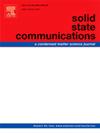应用于太阳能电池电极光电子器件的氧化镉锌纳米结构的合成及物理性质研究
IF 2.4
4区 物理与天体物理
Q3 PHYSICS, CONDENSED MATTER
引用次数: 0
摘要
采用不同Zn (x = 0.0、0.02、0.04、0.06、0.08和0.1)的水热法合成了(Cd)1-x(Zn)xO (CZO)纳米结构。本研究考察了其物理性质。XRD分析证实所有成分均为单相立方结构,晶粒尺寸从21.39 nm (x=0.0)减小到15.56 nm (x=0.1)。紫外可见光谱显示,随着锌含量的增加,光学带隙(Eg)从2.35 eV转变为2.52 eV。在相同的掺杂范围内,平均折射率(n)从3.72下降到2.66,消光(k)从6.2增加到7.9。热重分析(TGA)表明,随着锌浓度的增加,热稳定性得到改善。这些发现表明,锌掺杂有效地调节了CZO纳米结构的结构和光学性质,使其成为太阳能电池电极等光电应用的有希望的候选者。本文章由计算机程序翻译,如有差异,请以英文原文为准。
Synthesis and investigation of the physical properties of cadmium zinc oxide (CZO) nanostructures for optoelectronic device applications in solar cell electrodes
Different amounts of Zn (x = 0.0, 0.02, 0.04, 0.06, 0.08, and 0.1) were used in a hydrothermal process to synthesize the (Cd)1-x(Zn)xO (CZO) nanostructure. This study investigated its physical properties. XRD analysis confirmed a single-phase cubic structure for all compositions, with crystallite size decreasing from 21.39 nm () to 15.56 nm (). The UV–Vis spectra showed a shift in the optical band gap () from 2.35 eV to 2.52 eV with increasing Zn content. The average refractive index () decrease from 3.72 to 2.66, while the extinction () increased from 6.2 to 7.9 across the same doping range. Thermogravimetric analysis (TGA) demonstrated improved thermal stability with increasing Zn concentration. These findings reveal that Zn doping effectively tunes the structural and optical properties of CZO nanostructures, making them promising candidates for optoelectronic applications such as solar cell electrodes.
求助全文
通过发布文献求助,成功后即可免费获取论文全文。
去求助
来源期刊

Solid State Communications
物理-物理:凝聚态物理
CiteScore
3.40
自引率
4.80%
发文量
287
审稿时长
51 days
期刊介绍:
Solid State Communications is an international medium for the publication of short communications and original research articles on significant developments in condensed matter science, giving scientists immediate access to important, recently completed work. The journal publishes original experimental and theoretical research on the physical and chemical properties of solids and other condensed systems and also on their preparation. The submission of manuscripts reporting research on the basic physics of materials science and devices, as well as of state-of-the-art microstructures and nanostructures, is encouraged.
A coherent quantitative treatment emphasizing new physics is expected rather than a simple accumulation of experimental data. Consistent with these aims, the short communications should be kept concise and short, usually not longer than six printed pages. The number of figures and tables should also be kept to a minimum. Solid State Communications now also welcomes original research articles without length restrictions.
The Fast-Track section of Solid State Communications is the venue for very rapid publication of short communications on significant developments in condensed matter science. The goal is to offer the broad condensed matter community quick and immediate access to publish recently completed papers in research areas that are rapidly evolving and in which there are developments with great potential impact.
 求助内容:
求助内容: 应助结果提醒方式:
应助结果提醒方式:


